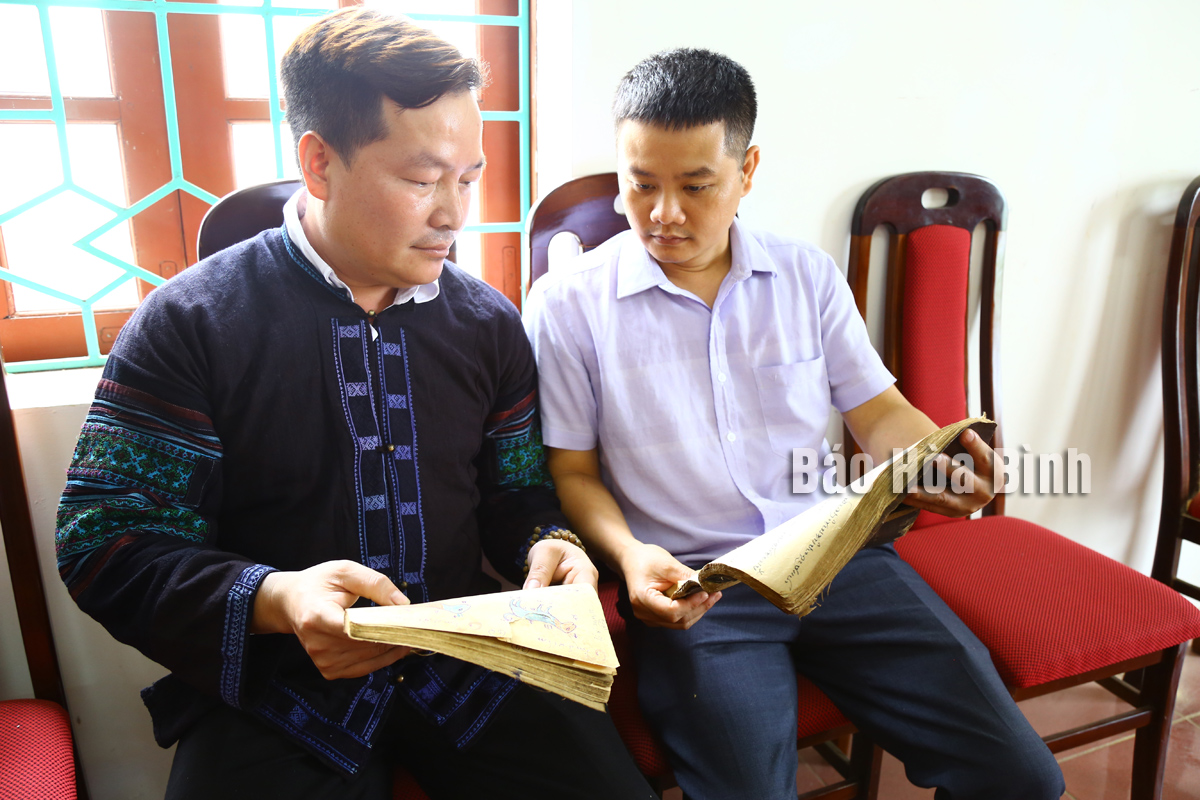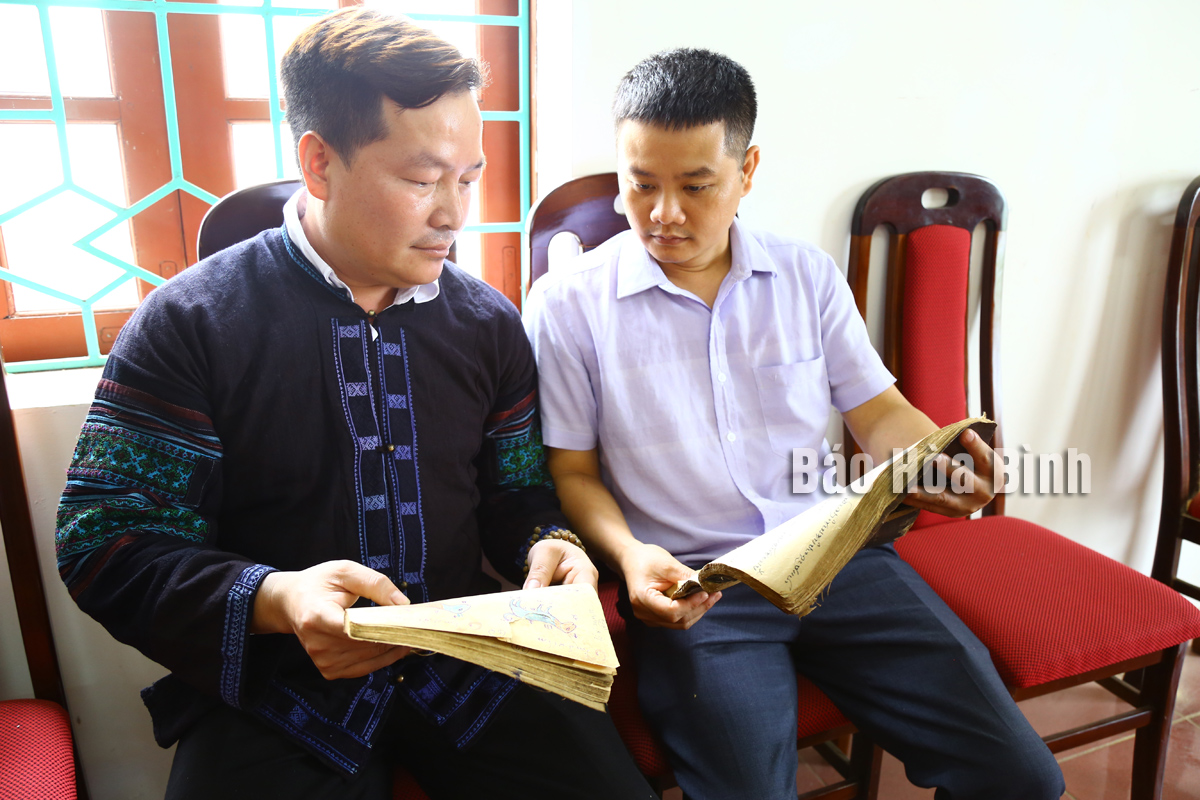
In Muong Chieng commune, Da Bac district, many people know Sa Van Cam, who is dedicated to preserving and promoting ancient Tay script. He has collected, documented and opened classes to teach this script, contributing to the preservation of the Tay ethnic cultural values in Muong Chieng commune and Hoa Binh province.
Sa Van Cam (left), a resident of Muong Chieng commune, Da Bac district, introduces books on ancient Tay scripts that he has preserved and promoted.
Born and grown up in Muong Chieng, where Tay ethnic group makes up over 70% of the population, Cam has accumulated extensive knowledge about Tay culture, including its ancient script. He said that the ancient Tay script has been preserved and handed down through generations. However, in modern times, many cultural values are fading, especially among the youth. To encourage the local Tay community and students to learn and write in their native script, he has studied and set up classes to preserve and promote the Tay language and writing.
Since 2010, Cam has organised seven classes for ancient Tay script, attracting over 200 learners from Muong Chieng and surrounding areas. Notably, in 2017, the Vietnam Institute of Linguistics in Hanoi collaborated him to offer a class on ancient Tay script and held a calligraphy competition in Muong Chieng, with Cam as the instructor. The same year, the Cau Muong festival was held in the commune to promote ancient Tay script to visitors.
Cam held that ancient Tay script differs significantly from the modern Thai script. He collected ancient books passed down to him by his ancestors to compile books and lesson plans to teach the people the Tay language. Despite financial difficulties in running these classes, his passion for imparting ancestral knowledge drives him to continue.
Cam has actively collaborated with the local folk culture club to maintain cultural and artistic activities while teaching ancient Tay script to its members. Many learners in his classes have become proficient in reading and writing the script. Currently, Cam's classes have over 30 attendees who learn three times a week at the community centre in Chieng Cang village.
Nguyen Quang Hieu, Deputy Head of the provincial Emulation - Commendation Commission, highlighted that Cam's model of "preserving and promoting the identity of ancient Tay script" provides significant social benefits by safeguarding and enhancing the Tay script and culture. It helps people better understand the rich and unique culture of the Tay ethnic group, he added. Cam's model has the potential to create a ripple effect and inspire broader influence across the province.
In recognition of his contribution to collecting folk culture, the provincial People’s Committee recognised Cam’s model as a provincial-level advanced example this year.
Hoa Binh province has carried out multiple programmes and initiatives to revive its cultural heritage which has gradually fallen into oblivion through the ebbs and flows of history.
The most prominent and defining feature in the prehistoric era of Hoa Binh is the Hoa Binh Culture. The Culture was first discovered in Hoa Binh. The significant prehistoric culture represents not only Vietnam but also Southeast Asia and southern China. Through excavations of cave sites in the limestone regions of Hoa Binh, French archaeologist M. Colani introduced the world to a "Stone Age in Hoa Binh province – Northern Vietnam" in 1927. On January 30, 1932, the First Congress of Far Eastern Prehistorians, held in Hanoi, officially recognised the Hoa Binh Culture.
Known as the "Land of Epic History”, Hoa Binh province, the gateway to Vietnam’s northwest, boasts a strategic location and a unique cultural tapestry woven by its ethnic minority communities.
The People's Committee of Luong Son District recently held a ceremony to receive the certificate recognizing Sau Communal House in Thanh Cao Commune as a provincial-level historical and cultural site.
Recognising the importance of cultural heritage preservation in protecting and promoting the value system of Vietnamese culture, and serving socio-economic development in the new period, Party committees and local administrations in Hoa Binh province have identified it as a key task in the cultural development strategy. The province has been making efforts in mobilising resources, creating consensus among people and engaging ethnic communities in preserving and promoting cultural identity.
Hoa Binh province has captured growing attention both domestically and internationally for its distinctive cultural heritage and rich history. Most notably, it has been renowned for its famous Hoa Binh culture, considered the cradle of ancient Vietnamese civilisation. Looking ahead to significant milestones in 2025 and the 140th anniversary of province establishment in 2026, Hoa Binh Newspaper presents a comprehensive overview of the province's development across economic, social, cultural, tourism, and security domains.



